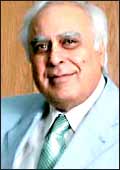 The
IITs, IIMs and AIIMS have always had a regimen they pride themselves
on, and for good reason; they are, arguably, the toughest schools
in the world to get into, and get out of, successfully. But if
you are a prospective student, be prepared to jostle for room,
literally, if you do make it past the exam; and don't blame the
institutes for your woes. They have to implement the 27 per cent
OBC quotas over the next three years. In order to ensure that
there is no reduction in the number of general category seats,
the government has mandated a 54 per cent increase in the total
number of seats. All the IIMs will implement the increase in a
phased manner: 6 per cent in the first year, 30 per cent in the
second year and 18 per cent in the third. But six months before
the admissions process for the next session starts, the Centre
is yet to clear their proposals for creating new infrastructure.
Result: most of these institutes do not have room to house the
additional students.
The
IITs, IIMs and AIIMS have always had a regimen they pride themselves
on, and for good reason; they are, arguably, the toughest schools
in the world to get into, and get out of, successfully. But if
you are a prospective student, be prepared to jostle for room,
literally, if you do make it past the exam; and don't blame the
institutes for your woes. They have to implement the 27 per cent
OBC quotas over the next three years. In order to ensure that
there is no reduction in the number of general category seats,
the government has mandated a 54 per cent increase in the total
number of seats. All the IIMs will implement the increase in a
phased manner: 6 per cent in the first year, 30 per cent in the
second year and 18 per cent in the third. But six months before
the admissions process for the next session starts, the Centre
is yet to clear their proposals for creating new infrastructure.
Result: most of these institutes do not have room to house the
additional students.
Consider this: IIT-Delhi, which has an annual budget of Rs 110
crore and a combined student strength of 4,800, will see that
number swell beyond 7,200 over the next three years. "We
have no room to accommodate such numbers," says an institute
official. "We're located in the middle of the city; increasing
infrastructure (dormitories, canteens, classrooms, technical resources,
recreational facilities, etc.) will require a capital expenditure
of Rs 800 crore, but we haven't yet received any sanction from
the government," he adds.
IIM-A, which faces a similar predicament, has, in anticipation
of such shortages, reportedly begun renting flats in its vicinity.
"We are planning to construct new facilities, but that will
take at least two years. So, in the short term, we have little
choice but to go in for private accommodation," says an official.
"It will be a tight squeeze," says Anindya Sen, Dean,
IIM-C, which will see the number of seats swell from 300 to 463
in three years. It has already earmarked an investment of Rs 50
crore from its own corpus to increase infrastructure.
Prakash G. Apte, Director, IIM-B, however, is confident that
the increase will pose no major challenge. "Students of programmes
such as executive education are not provided accommodation on
campus anyway, so there shouldn't be an issue of over-crowding
at IIM-B," he says. "We have enough spare capacity to
house the additional students next year. Thereafter, we will build
new hostel blocks on the campus itself."
IIT Powai, which occupies 500 acres of land and has a total
on-campus student strength of 5,270, is considering setting up
satellite campuses. "We're discussing proposals with the
governments of Goa, Gujarat and Maharashtra," says its spokesperson.
Infrastructure woes aside, all institutes, without exception,
are understaffed. "The present teacher-students ratio is
1:7; this may decline to 1:14. Is that the right approach (to
higher education)?" laments Apte. HRD Ministry officials
were unavailable for comment on the issues.
"IIM is a globally recognised brand and any controversy
over something as simple as finding accommodation could affect
its brand equity," says Kris Laxmikanth, CEO, The Headhunters,
a Bangalore-based hr Consultancy.
The qualitative downgrading of India's finest institutes is
obviously a small price to pay in the eyes of those who value
their vote banks more.
-Aman Malik, Ritwik Mukherjee
& Rahul Sachitanand
Whither
Cost Cutting
BABUS DON'T RETIRE
Some bureaucrats who continue
to occupy office long after their tenures ended. |
| G. Madhavan, an IAS officer of the 1967 batch,
retires as Haryana Chief Secretary on October 31, 2005, and
joins as Chief Information Commissioner of the state the next
day
Pratyush Sinha, an IAS officer of the 1969 batch, retires
as Secretary, Department of Personnel and Training, in July
2006, and is made Central Vigilance Commissioner in September
2006
Labanyendu Mansingh, an IAS officer of the 1970 batch,
retires as Secretary, Consumer Affairs, in November 2006,
and emerges in January 2007 as the lead candidate for the
post of Petroleum regulator
K. Padmanabhaiah, former Home Secretary, continues as
the Centre's interlocutor with Naga rebels about nine years
after he retired
This is not an exhaustive list
|
Prime
minister Manmohan Singh may want his ministers to cut out wasteful
expenditure. Finance Minister P. Chidambaram may want his colleagues
to cut down flab in their ministries. But their exhortations are
obviously falling on deaf ears. Want proof? Just look at the number
of retired bureaucrats, policemen, military officers and judges
who continue to hold official positions long after they have demitted
regular office (see Babus Don't Retire).
"Scores of positions are 'created' for
the continued employment of retired IAS officers. For example,
a recently-retired Agriculture Secretary is tipped to become Chairperson
of the National Rainfed Area Development Authority (NRADA),"
says a retired bureaucrat on condition of anonymity. T.S. Krishnamurthy,
former Chief Election Commissioner, believes that 25 per cent
of the strength of the central government can easily be sheared.
"Several commissions have advised the government against
indiscriminate rehabilitation of former public servants. But no
one is listening. The lure of public offices after retirement
is compromising the character of public servants. And huge amounts
of wasteful expenditure is being incurred on them," he says.
The P.C. Hota Committee on Civil Services
Reforms says: "We received overwhelming evidence that the
temptation of post-retirement assignments under government/statutory/constitutional
authorities has made senior civil servants servile and pliable."
T.S.R. Subramanian, former Cabinet Secretary, says there are any
number of government bodies, tribunals and commissions that have
no reason to exist. "Bodies like cat, BIFR, AAIFR have become
self-perpetuating mechanisms. Commissions like the Liberhan panel
(probing the Ayodhya episode) are still going strong after 13
years," he adds.
The irony couldn't be more stark. While retired
mandarins continue to enjoy cushy sinecures-complete with bungalows,
official cars and other bells and whistles of high office; it
has been estimated that each of these retired officials costs
the goverment a minimum of Rs 1 lakh a month-middle level bureaucrats
complain of career stagnation and shortage of housing and other
facilities. But does anyone care?
-Kapil Bajaj
6 NEW PALACE ON WHEELS PLANNED
 Hhe
Indian railways continues to display its new market-savvy. Buoyed
by demand for its super luxury Palace on Wheels, the Railways
is all set to launch six more such trains, starting from September
this year. The first train will ply from Bangalore and touch Mysore,
Hassan, Hospet, Hubli, Humpi and Goa. Then, it is planning another
Palace on Wheels for Rajasthan, with a route that's different
from the one followed by the first. Other such trains are planned
for tours of Punjab and the four southern states. The Railways
is also planning another such train connecting India's top 10
tourist destinations. Since they are targeted mainly at foreign
tourists, the dollar-denominated fares are a fairly steep $400
(Rs 18,000) per day for a week-long trip. Hhe
Indian railways continues to display its new market-savvy. Buoyed
by demand for its super luxury Palace on Wheels, the Railways
is all set to launch six more such trains, starting from September
this year. The first train will ply from Bangalore and touch Mysore,
Hassan, Hospet, Hubli, Humpi and Goa. Then, it is planning another
Palace on Wheels for Rajasthan, with a route that's different
from the one followed by the first. Other such trains are planned
for tours of Punjab and the four southern states. The Railways
is also planning another such train connecting India's top 10
tourist destinations. Since they are targeted mainly at foreign
tourists, the dollar-denominated fares are a fairly steep $400
(Rs 18,000) per day for a week-long trip.
IRCTC (Indian Railway Catering and Tourism Corporation) is also
considering a proposal by The Oberoi Group of Hotels to run and
manage a third luxury tourist train for Rajasthan. "With
a six-month waiting list for the Palace on Wheels, there is scope
for more such trains," says P.K. Goel, MD, IRCTC.
-Pallavi Srivastava
Gujarat
Rakes It In
It
is raining investments in Gujarat and the Vibrant Gujarat Global
Investors Summit 2007 merely confirmed that. The state has received
investment commitments of Rs 4.5 lakh crore from some of the biggest
names in Corporate India and importantly, the investments will
be spread across a medley of sectors ranging from SEZs, textiles,
engineering and energy. According to conservative estimates, a
million jobs will be created in the process. Says Anil Ambani,
Chairman, R-ADAG: "Gujarat is among the most exciting growth
stories unfolding anywhere in India and perhaps even in the world."
But the most telling comment came from Tata Group Chairman Ratan
Tata. "You have to be stupid to not invest in Gujarat,"
he said.
-Krishna Gopalan
Bonanza
Likely for Scientists
 It's
now completely up to finance Minister P. Chidambaram to incentivise
and motivate scientists working at government institutions and
laboratories. Science & Technology Minister Kapil Sibal (left)
has recommended that scientists who develop new technologies or
products be granted a minimum of 30 per cent of the royalties
that come from their commercialisation.
It's
now completely up to finance Minister P. Chidambaram to incentivise
and motivate scientists working at government institutions and
laboratories. Science & Technology Minister Kapil Sibal (left)
has recommended that scientists who develop new technologies or
products be granted a minimum of 30 per cent of the royalties
that come from their commercialisation.
"This is necessary to encourage the commercialisation of
genuine innovations. It will provide a fillip to Indian exports
and domestic production and reward scientists," says Sibal,
who proposes to bring in legislation similar to the Bayh-Dole
Act of The Untied States to bring about this change. Will the
fm play ball?
-Amit Mukherjee
GURU
AKA DHIRUBHAI?
 Ace filmmaker Mani Ratnam may turn
blue in the face denying that his latest movie, Guru, is not based
on the life of the late Reliance founder Dhirubhai Ambani, but
the opening sequence leaves little to imagination. The movie opens
with industrialist Gurukant Desai aka Gurubhai (sounds familiar?)
taking a walk down memory lane, even as he waits for his company's
shareholders' meeting to begin. The location: a cricket stadium
in Mumbai that Dhirubhai Ambani himself used to hold annual general
meetings in.
Ace filmmaker Mani Ratnam may turn
blue in the face denying that his latest movie, Guru, is not based
on the life of the late Reliance founder Dhirubhai Ambani, but
the opening sequence leaves little to imagination. The movie opens
with industrialist Gurukant Desai aka Gurubhai (sounds familiar?)
taking a walk down memory lane, even as he waits for his company's
shareholders' meeting to begin. The location: a cricket stadium
in Mumbai that Dhirubhai Ambani himself used to hold annual general
meetings in.
Even before its release on January 12, the movie generated a
lot of heat about the plot closely following Ambani's life. The
film industry and the corporate grapevine was abuzz with rumours
that the late patriarch's elder son and Reliance Industries Chairman
Mukesh Ambani had wanted a sneak preview of the movie before it
hit the screens. Whether that happened or not is anybody's guess.
Reliance officials declined to comment. However, Mukesh's estranged
sibling and R-ADAG Chairman Anil Ambani, who owns Adlabs, may
not have any great objection to the movie. In fact, many see Adlabs
picking up the distribution rights of Guru for the Delhi, Punjab
and Uttar Pradesh territories as his indifference to, if not approval
for, the movie.
-T.V. Mahalingam
|






 H
H
 Ace filmmaker Mani Ratnam may turn
blue in the face denying that his latest movie, Guru, is not based
on the life of the late Reliance founder Dhirubhai Ambani, but
the opening sequence leaves little to imagination. The movie opens
with industrialist Gurukant Desai aka Gurubhai (sounds familiar?)
taking a walk down memory lane, even as he waits for his company's
shareholders' meeting to begin. The location: a cricket stadium
in Mumbai that Dhirubhai Ambani himself used to hold annual general
meetings in.
Ace filmmaker Mani Ratnam may turn
blue in the face denying that his latest movie, Guru, is not based
on the life of the late Reliance founder Dhirubhai Ambani, but
the opening sequence leaves little to imagination. The movie opens
with industrialist Gurukant Desai aka Gurubhai (sounds familiar?)
taking a walk down memory lane, even as he waits for his company's
shareholders' meeting to begin. The location: a cricket stadium
in Mumbai that Dhirubhai Ambani himself used to hold annual general
meetings in.